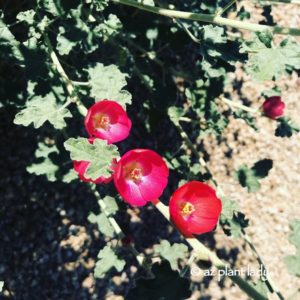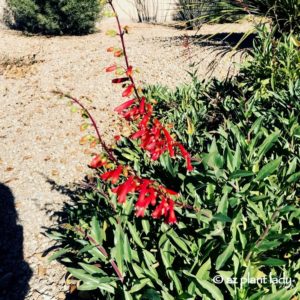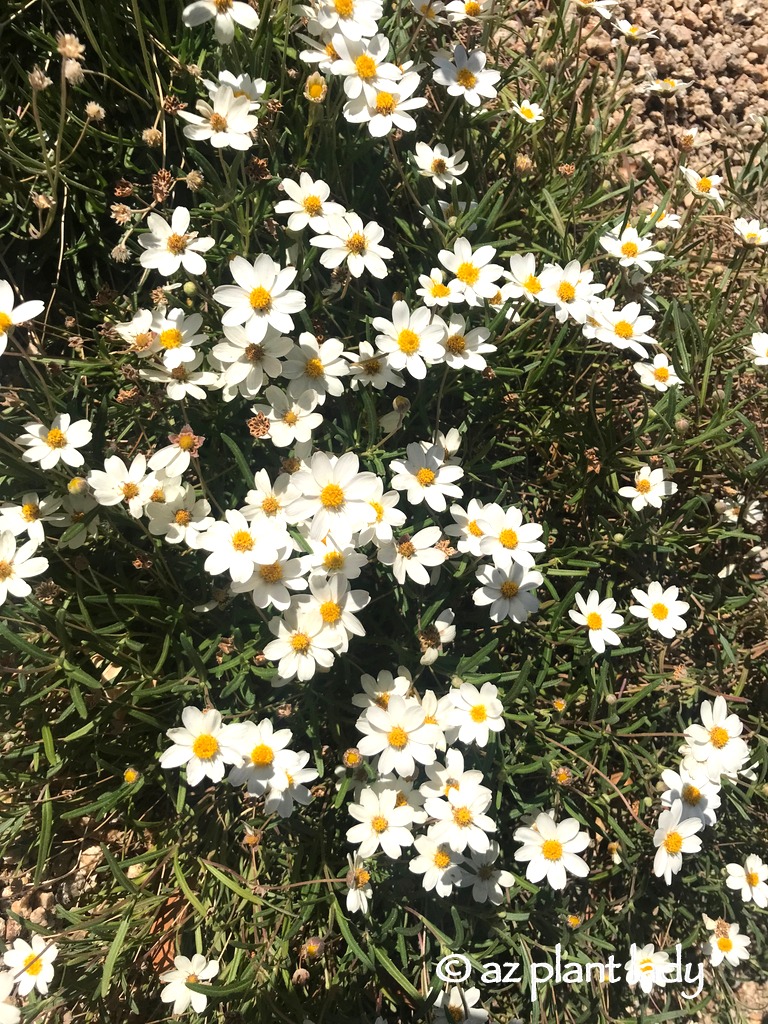Living in the desert southwest has many advantages, including being able to have a landscape filled with winter blooms all winter long when gardens throughout much of the country are brown or covered in a layer of snow.
Over the weekend, I stepped out into my garden to see how my plants were doing and took photos of those that were flowering.
**I’ve provided links to earlier blog posts where you can learn more about these plants and see if they deserve a home in your landscape.
First, were the globe mallow, which is just beginning to produce their colorful blooms. While the most common type produces orange flowers, they do come in other colors as well. I have red, pink, and white ones in my garden. You can learn more about this plant in an earlier blog post.

Despite its small size, angelita daisy is a small powerhouse in the landscape that blooms off and on all year long. They thrive in full sun and look great when grouped next to boulders. During my walk through the garden, I discovered that this one has a volunteer Parry’s penstemon (Penstemon parryi) growing next to it. I’ll leave it alone as they will look great together.
This perennial delights hummingbirds with its red-orange blooms that appear in January and last well into spring. There are many different kinds of penstemon, which thrive in drought-tolerant gardens and firecracker penstemon is by far, my favorite.

The delicate flowers of this ground cover don’t look like they can survive the intense heat of the desert garden, but blackfoot daisy thrives all year long with little fuss. I have mine growing alongside boulders and at the base of cactuses. I haven’t been able to determine exactly when they are supposed to bloom because mine always seem to be flowering.
This groundcover form of lantana is a popular staple in the drought-tolerant landscape, but you seldom see it with two different colors. In winter, it is usually touched by some frost damage, but our weather has been unusually warm, so it is still flowering. Normally, you see all white or all purple, but not both together. While there is a variety called ‘Lavender Swirl’; it can be hard to find and somewhat expensive. I’ve replicated the same look in my garden, which I share in this earlier blog post.
Here is the newest addition to the front garden. It shouldn’t be blooming this time of year, but again, with the mild winter, it is getting a head start on spring. ‘Sparky’ Tecoma is a new plant that is a cross between yellow bells and orange bells. The flowers are apricot in color with deep maroon centers. This shrub was created by an ASU professor, who named it after the school’s mascot. I am very excited to see it reveal its lovely flowers on either side of our large front window.
Do you have any plants that bloom in winter? Inside or outside, please share what is happening in your garden this month.
~ ~ ~ ~ ~ ~ ~ ~ ~ ~ ~ ~ ~ ~ ~ ~ ~ ~ ~ ~ ~ ~ ~ ~ ~ ~ ~ ~ ~ ~
Did you know that up to 70% of water use is outdoors? That’s why we love desert plants and feature them each month. Fall is a great time to plant! Learn more about plants for your landscape in our Arizona Low-Water-Use Plants page. Visit our page on Choosing and Planting Low Water-Use Plants for tips on plant selection and how to plant properly. Also, be sure to read through all of our featured Plant of the Month blogs!
This blog originally appeared on Ramblings from a Desert Garden and is being reprinted with permission. Water – Use It Wisely is proud to feature guest bloggers who write about topics related to water and water conservation. The author of this blog, Noelle Johnson, is an urban horticulturist, Certified Arborist and freelance garden-writer who helps people create beautiful, low-maintenance gardens through helpful advice on her blog www.azplantlady.com. She is passionate about teaching people about the amazing desert plants that thrive in our landscapes.


